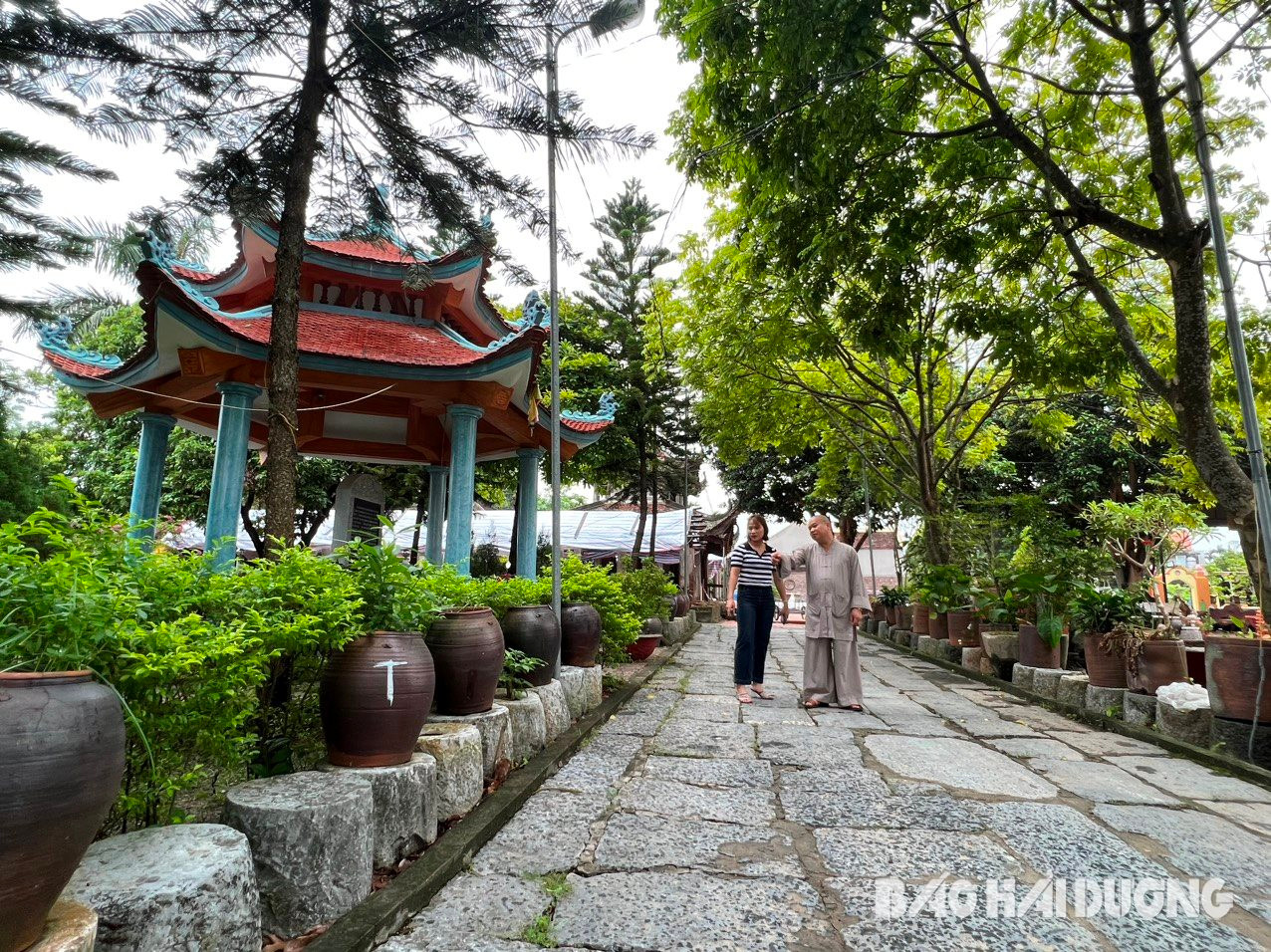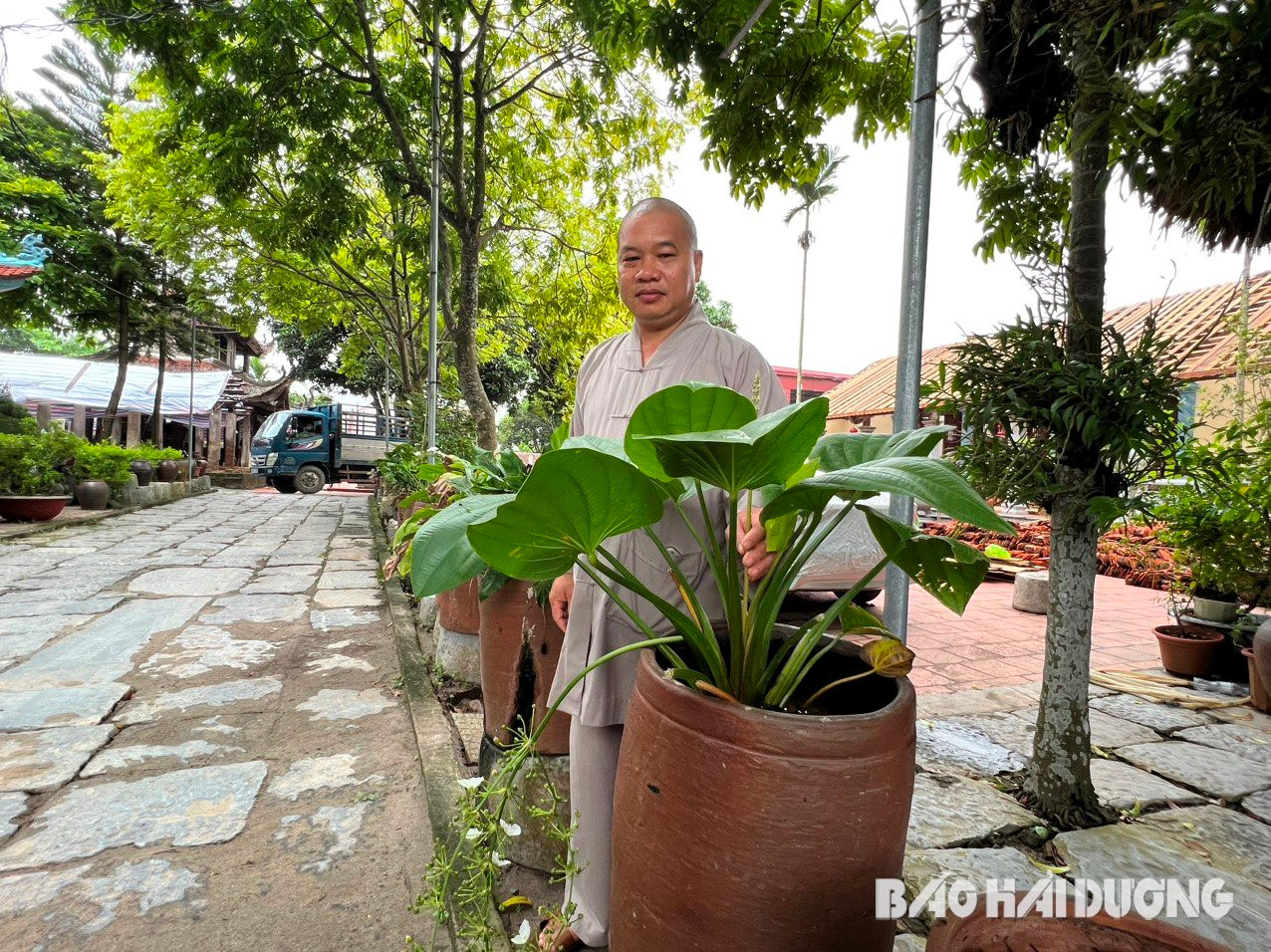Quiet space, harmonious beauty and preserving many precious artifacts from everyday life – Nghi Khe pagoda, Tan Ky commune (Tu Ky, Hai Duong) now has a unique beauty.

Stone slabs,jars, jars, mortars, stone shafts… are arranged neatly and neatly in Nghi Khe Pagoda
A feat of keeping
The road from the village leading to Nghi Khe Pagoda surprises visitors because it is stretched with green stone slabs. The closer you get to the temple, the more eye-catching the road becomes because of the two rows of jars, jars, stone shafts… decorated on the side of the road. Perhaps very few pagodas have a special entrance path like Nghi Khe Pagoda.
Venerable Thich Thanh Hai has been the abbot of Nghi Khe Pagoda since 2007. According to the Venerable’s share, Nghi Khe Pagoda was built in the 17th century according to foreign internal palace architecture.
In addition to worshiping Buddha, the pagoda also worships General Nguyen Dinh Thiem, a son of his hometown who lived in the 17th century. The main hall is made of four-iron wood, but the columns of the 20 pavilion spaces are made of Thanh Hoa green ironstone.
Another difference is that one side of the column is square, and the other side is round to represent the full life of the temple builders. The pagoda was ranked as a national historical relic in 1997.
After returning to become an abbot at the pagoda, the Venerable found that in the village and in the commune, there were many families that still kept the stone slabs used in the past to pave roads, stone mortars, rice shafts, jars, ceramic jars… but kept them.
rolling around on the edge of the pond, in the kitchen, at the end of the garden… With the idea of wanting to preserve the old countryside features and continue to build a temple with unique and different features, Venerable has mobilized people to support , collect these items and put them in the temple.

Many jars and jars in the temple are used to grow flowers and ornamental plants
After 9 years of hard work, in early 2015, when the number of stone slabs, jars, jars… was relatively large and people in the village and commune actively supported, the pagoda began to be renovated.
“The most difficult thing is constructing the road from the entrance gate to the temple courtyard. The stone slabs are heavy and rough, so it takes a lot of time and effort to transport and arrange. We have to mobilize many machines and talented people. It’s very healthy, there are places where you have to dig deep to place the stones.
Choosing the stones to match each other also takes a lot of time,” Venerable Thich Thanh Hai said.
After more than a month of construction, the stone road, hundreds of meters long and 3-5 meters wide, was completed. In the temple, there are also flowers and ornamental plants planted in many jars and jars. In the temple grounds, there are many trees, flowers, jade wells, thatched houses… creating a peaceful scene, typical of ancient Northern villages.
People join forces

The entrance to Nghi Khe Pagoda is covered with lush green trees, combined with stone roads, creating a very unique beauty.
To have the green landscape of Nghi Khe Pagoda like today, the contributions of many people in Tan Ky commune must be included. Ms. Do Thi Thu Huong, cultural civil servant of Tan Ky commune,
said that in response to the abbot’s beautiful actions, many families proactively brought items to support the pagoda, including 90% of the people of Nghi Khe village. . After being built, the space of the pagoda has a different beauty than before, becoming a place to rest and sightsee for many people in the village, commune, and people returning from home.
As one of the people who donated and actively propagated and mobilized people to support items for the pagoda, Mr. Nguyen Nang Xoa, Head of Nghi Khe village, said that the pagoda’s work is of great significance in preserving the pagoda. , preserving the beauty of the village.
Although these items existed in the village for a long time, they were gradually forgotten. “When you gather together inanimate objects that seem to have no value anymore, you create a new, strange project.
Not only does it beautify the pagoda, but it also contributes to preserving the cultural features of our ancestors. We hope this work will be preserved to help future generations learn a part about the lives of our ancestors in the past,” said Mr. Xoa.





